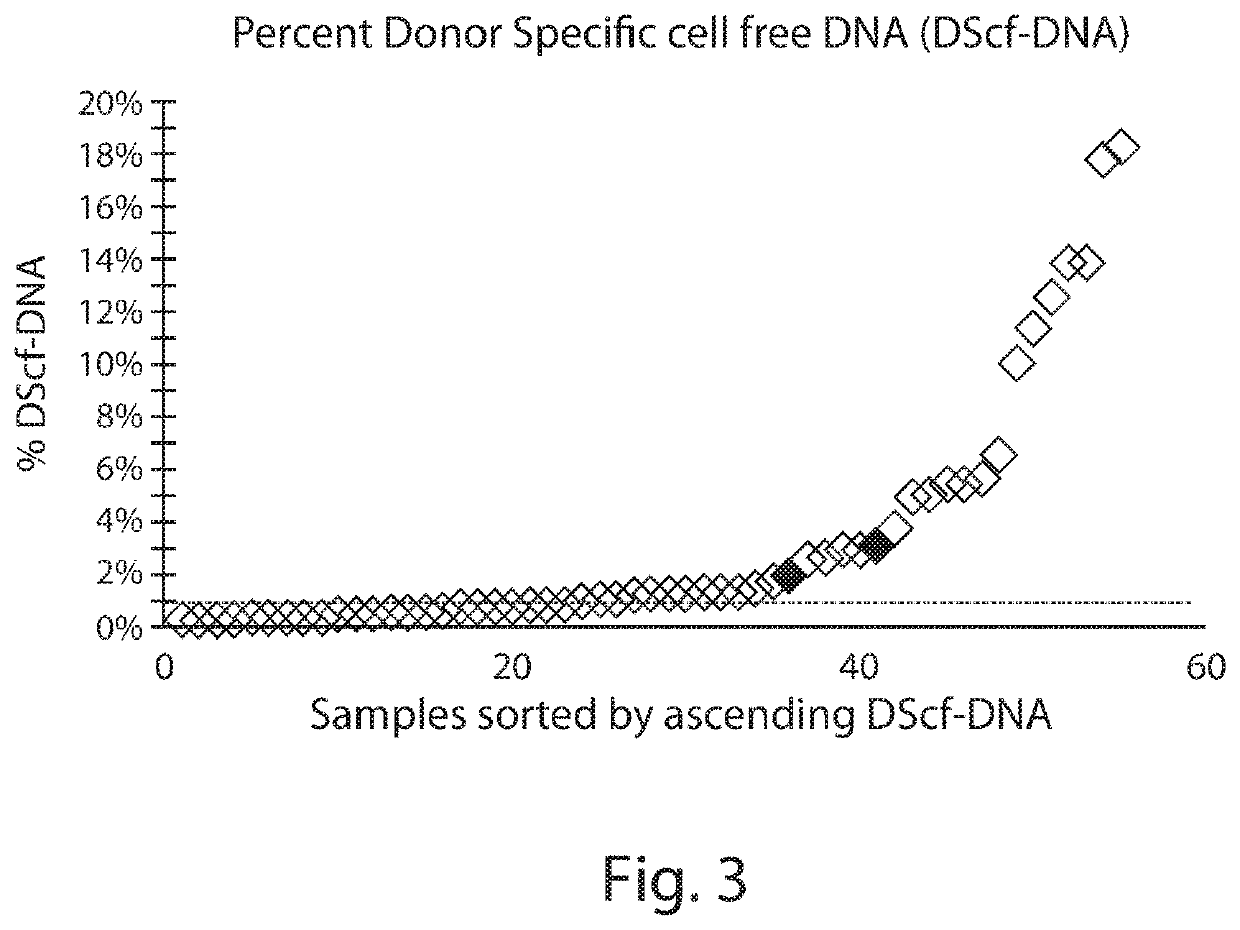Methods for assessing risk using total and specific cell-free DNA
a cell-free dna and risk assessment technology, applied in the direction of microbiological testing/measurement, biochemistry apparatus and processes, etc., can solve the problems of limited current methods for quantitative analysis of nucleic acid populations
- Summary
- Abstract
- Description
- Claims
- Application Information
AI Technical Summary
Benefits of technology
Problems solved by technology
Method used
Image
Examples
example 1
Amplification Assay (MOMA)
SNV Target Selection
[0120]Identification of targets for multiplexing in accordance with the disclosure may include one or more of the following steps, as presently described. First, highly heterozygous SNPs can be screened on several ethnic control populations (Hardy-Weinberg p >0.25), excluding known difficult regions. Difficult regions include syndromic regions likely to be abnormal in patients and regions of low complexity, including centromeres and telomeres of chromosomes. Target fragments of desired lengths can then be designed in silico. Specifically, two 20-26 bp primers spanning each SNP's 70 bp window can be designed. All candidate primers can then be queried to GCRh37 using BLAST. Those primers that were found to be sufficiently specific can be retained, and monitored for off-target hits, particularly at the 3′ end of the fragment. The off-target candidate hits can be analyzed for pairwise fragment generation that would survive size selection. Se...
example 2
Assays
[0128]A multiplexed, allele-specific quantitative PCR-based assay can be used to calculate donor fraction (DF) as a percentage of cf-DNA. A panel of high frequency SNPs are selected for their ability to reliably discriminate between alleles. Briefly, 15 ng of total cf-DNA is added to a multiplexed library master mixture with an exogenous standard spiked into each sample (4.5E+03 copies) and amplified by PCR for 35 cycles in a 25 ul reaction containing 0.005 U Q5 (NEB) DNA polymerase, 0.2 mM dNTPs, 3 uM forward primer pool of 96 targets, 3 uM reverse primer pool of 96 targets, at a final concentration of 2 mM MgCl2.
[0129]Cycling conditions can be 98° C. for 30 s, then 35 cycles of 98° C. for 10 s, 55° C. for 40 s, and 72° C. for 30 s. This can then be finished with a 2-minute incubation at 72° C. and then stored at 4° C. Ten microliters of the final reaction is cleaned up with ExoSAP-IT (Thermo Fisher Scientific) by incubating at 37° C. for 15 minutes followed by 80° ...
example 3
tion of Total Cell-Free DNA
[0133]In some embodiments, the total cell-free DNA (cf-DNA) is determined. Three to ten milliliters (ml) of anti-coagulated blood is collected in 10 ml Cell-Free DNA Blood Collection Tubes (BCT) tubes (Streck, Omaha, Nebr.). Plasma is separated from whole blood by centrifugation and stored at −80° C. until DNA extraction. Cf-DNA extractions may be performed using ReliaPrep™ HT Circulating Nucleic Acid Kit, Custom (Promega, Madison, Wis.).
[0134]Total cf-DNA content from plasma is evaluated in triplicate by quantitative real-time PCR as previously described (Hidestrand et al., Influence of temperature during transportation on cell-free DNA analysis. Fetal Diagn Ther 31, 122-128 (2012)). PCR analysis is carried out on an Applied Biosystems QuantStudio 7 Flex Real-Time PCR System (Thermo Fisher Scientific, Waltham, Mass.).
PUM
| Property | Measurement | Unit |
|---|---|---|
| time | aaaaa | aaaaa |
| time | aaaaa | aaaaa |
| time | aaaaa | aaaaa |
Abstract
Description
Claims
Application Information
 Login to View More
Login to View More - R&D
- Intellectual Property
- Life Sciences
- Materials
- Tech Scout
- Unparalleled Data Quality
- Higher Quality Content
- 60% Fewer Hallucinations
Browse by: Latest US Patents, China's latest patents, Technical Efficacy Thesaurus, Application Domain, Technology Topic, Popular Technical Reports.
© 2025 PatSnap. All rights reserved.Legal|Privacy policy|Modern Slavery Act Transparency Statement|Sitemap|About US| Contact US: help@patsnap.com



